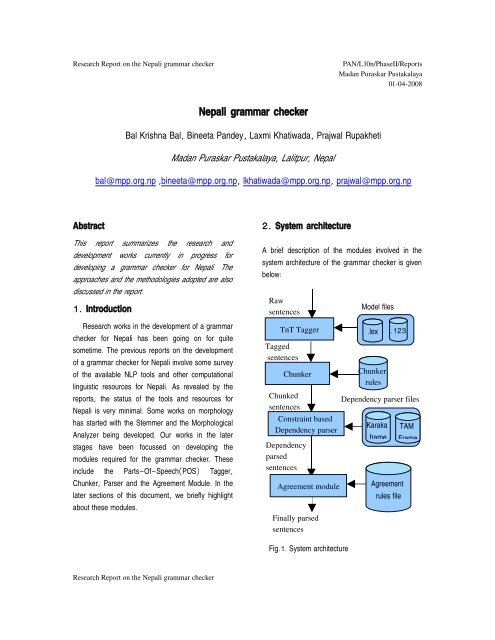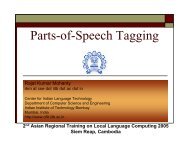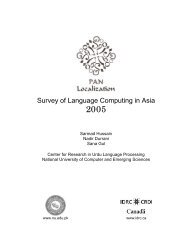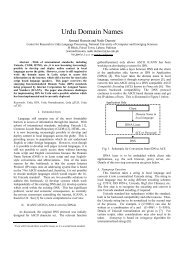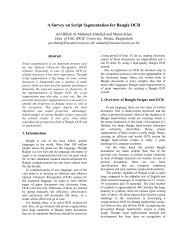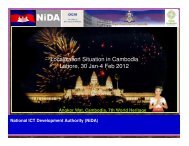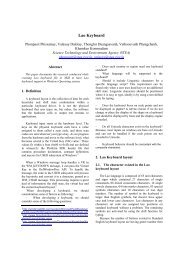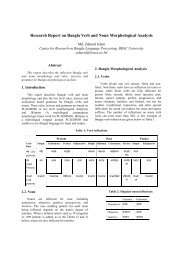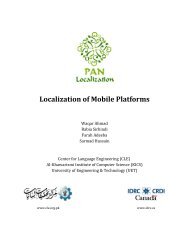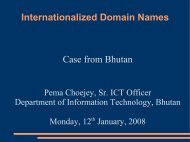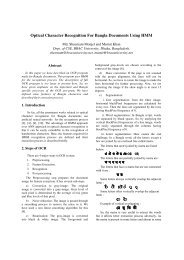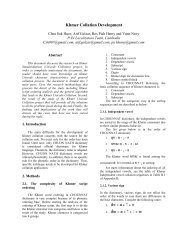Research Report on Nepali Grammar Checker - PAN Localization
Research Report on Nepali Grammar Checker - PAN Localization
Research Report on Nepali Grammar Checker - PAN Localization
You also want an ePaper? Increase the reach of your titles
YUMPU automatically turns print PDFs into web optimized ePapers that Google loves.
<str<strong>on</strong>g>Research</str<strong>on</strong>g> <str<strong>on</strong>g>Report</str<strong>on</strong>g> <strong>on</strong> the <strong>Nepali</strong> grammar checker<br />
<strong>PAN</strong>/L10n/PhaseII/<str<strong>on</strong>g>Report</str<strong>on</strong>g>s<br />
Madan Puraskar Pustakalaya<br />
01042008<br />
<strong>Nepali</strong> grammar checker<br />
Bal Krishna Bal,<br />
Bineeta Pandey, Laxmi Khatiwada, Prajwal Rupakheti<br />
Madan Puraskar Pustakalaya, Lalitpur,<br />
Nepal<br />
bal@ mpp. org.<br />
np , bineeta@ mpp. org.<br />
np, lkhatiwada@ mpp. org.<br />
np, prajwal@ mpp. org.<br />
np<br />
Abstract<br />
This report summarizes the research and<br />
development works currently in progress for<br />
developing a grammar checker for <strong>Nepali</strong>.<br />
The<br />
approaches and the methodologies adopted are also<br />
discussed in the report.<br />
1. Introducti<strong>on</strong><br />
<str<strong>on</strong>g>Research</str<strong>on</strong>g> works in the development of a grammar<br />
checker for <strong>Nepali</strong> has been going <strong>on</strong> for quite<br />
sometime.<br />
The previous reports <strong>on</strong> the development<br />
of a grammar checker for <strong>Nepali</strong> involve some survey<br />
of the available NLP tools and other computati<strong>on</strong>al<br />
linguistic resources for <strong>Nepali</strong>.<br />
reports,<br />
As revealed by the<br />
the status of the tools and resources for<br />
<strong>Nepali</strong> is very minimal.<br />
Some works <strong>on</strong> morphology<br />
has started with the Stemmer and the Morphological<br />
Analyzer being developed.<br />
Our works in the later<br />
stages have been focussed <strong>on</strong> developing the<br />
modules required for the grammar checker.<br />
These<br />
include the Parts-Of- Speech( POS) Tagger ,<br />
Chunker, Parser and the Agreement Module.<br />
In the<br />
later secti<strong>on</strong>s of this document,<br />
about these modules.<br />
we briefly highlight<br />
2. System architecture<br />
A brief descripti<strong>on</strong> of the modules involved in the<br />
system architecture of the grammar checker is given<br />
below:<br />
Raw<br />
sentences<br />
TnT Tagger<br />
Tagged<br />
sentences<br />
Chunker<br />
Chunked<br />
sentences<br />
C<strong>on</strong>straint based<br />
Dependency parser<br />
Dependency<br />
parsed<br />
sentences<br />
Agreement module<br />
Finally parsed<br />
sentences<br />
Model files<br />
.lex .123<br />
Chunker<br />
rules<br />
Dependency parser files<br />
Karaka<br />
frame<br />
Agreement<br />
rules file<br />
TAM<br />
Frame<br />
Fig.1.<br />
System architecture<br />
<str<strong>on</strong>g>Research</str<strong>on</strong>g> <str<strong>on</strong>g>Report</str<strong>on</strong>g> <strong>on</strong> the <strong>Nepali</strong> grammar checker
<str<strong>on</strong>g>Research</str<strong>on</strong>g> <str<strong>on</strong>g>Report</str<strong>on</strong>g> <strong>on</strong> the <strong>Nepali</strong> grammar checker<br />
<strong>PAN</strong>/L10n/PhaseII/<str<strong>on</strong>g>Report</str<strong>on</strong>g>s<br />
Madan Puraskar Pustakalaya<br />
01042008<br />
2.1. Parts- of- Speech( POS)<br />
Tagger<br />
For the purpose of the POS Tagger for<br />
<strong>Nepali</strong>,<br />
we have adapted TnT 1 , a free POS<br />
Tagger that follows a tri-<br />
gram statistical<br />
approach for POS Tagging.<br />
trigram approach,<br />
Besides the<br />
TnT has the smoothing<br />
technique incorporated into it.<br />
The<br />
smoothing technique basically implies the<br />
c<strong>on</strong>siderati<strong>on</strong> of bi- gram, uni-<br />
gram as<br />
well as n- grams while tagging.<br />
The <strong>Nepali</strong><br />
POS Tagset used by the tagger has<br />
tags.<br />
For training the POS Tagger,<br />
43<br />
we have<br />
developed a training corpus of manually<br />
POS Tagged text of around 8,000 words .<br />
The corpus is preserved in XML format<br />
with the tag < w > for each word and its<br />
POS tag is marked by attr attribute in the<br />
attribute column.<br />
In order to use this corpus<br />
for training TNT,<br />
we have written a<br />
c<strong>on</strong>verter applicati<strong>on</strong> in Java that can<br />
c<strong>on</strong>vert the corpus from the XML format to<br />
the required TNT format i. e.<br />
a single line<br />
c<strong>on</strong>taining a word and corresp<strong>on</strong>ding POS<br />
column.<br />
The training model of TnT extracts useful<br />
informati<strong>on</strong> in the two model files, namely ,<br />
. lex and .123 files,<br />
which basically store<br />
learnt patterns and other useful informati<strong>on</strong><br />
from the training corpus.<br />
2.2. Chunker<br />
The chunker module takes the POS<br />
Tagged Text from the POS Tagger Module<br />
and identifies the chunks in the sentence .<br />
For identifying the chunks,<br />
the chunker<br />
module c<strong>on</strong>sults the chunk rule file .<br />
Currently we have about<br />
and<br />
11<br />
chunkset.<br />
13<br />
chunk rules<br />
chunks identified for the <strong>Nepali</strong><br />
Linguistic rules for chunking is<br />
c<strong>on</strong>verted into a set of regular expressi<strong>on</strong>s<br />
and represented in the form of a c<strong>on</strong>text<br />
free grammar formalism.<br />
A sample of the<br />
rules in the chunk rule file is presented<br />
below:<br />
NCH:( DET)?(( NUM)( CL)?)?( INT)?(<br />
AD<br />
J)*(( NN)|( NP)|( PP))(( PLE)|( PLAI))?<br />
JOCH:( ADJ)*(( NN)|( NP)|( PP))( PKO)<br />
NCH:(( VNE)|( VKO))(( NN)|( NP)|<br />
( POP))(( PLE)|( PLAI))?<br />
FVCH:( VOP)|( VKO)|(( VI)( VF))|( VAUX)|<br />
( VF)<br />
NVCH:( VOP)|(( VOP)( VKO))<br />
GVCH:( VI)|( VNE)<br />
AJCH:( INT)?( ADJ)<br />
AVCH:( INT)*(( ADV)+|( VOP)+)<br />
PNCH:( YM)|( YF)|( YB)<br />
CNCH:( CCON)<br />
Fig. 2.<br />
Sample of chunk rules<br />
1 TnT is a very efficient statistical partofspeech<br />
tagger that is trainable <strong>on</strong> different languages and<br />
virtually any tagset.<br />
While the n<strong>on</strong>-<br />
terminal symbols <strong>on</strong> the<br />
right are the chunks,<br />
the terminal symbols<br />
to the left are the POS Tags taken from the<br />
<strong>Nepali</strong> POS Tagset.<br />
The n<strong>on</strong>terminals and<br />
the terminals are separated by the<br />
“:”<br />
<str<strong>on</strong>g>Research</str<strong>on</strong>g> <str<strong>on</strong>g>Report</str<strong>on</strong>g> <strong>on</strong> the <strong>Nepali</strong> grammar checker
<str<strong>on</strong>g>Research</str<strong>on</strong>g> <str<strong>on</strong>g>Report</str<strong>on</strong>g> <strong>on</strong> the <strong>Nepali</strong> grammar checker<br />
symbol.<br />
For the implementati<strong>on</strong> of the chunker<br />
module,<br />
we have devised a simple<br />
algorithm which we describe below:<br />
Let us say we have following n rules for<br />
defining n chunks:<br />
Pattern 1-> chunk 1<br />
Pattern 2- > chunk 2<br />
…<br />
…<br />
…<br />
Pattern n -> chunk n<br />
Now,<br />
if a given sentences has the following<br />
pattern of POS tags for its respective<br />
lexemes:<br />
T1 T2 T3 T4 T5…Tk<br />
Then,<br />
we proceed the chunking as shown<br />
below:<br />
2.3. Parser Module<br />
T1 T2 T3 T4 T5… Tk1 Tk<br />
The parser module is still in the research<br />
phase.<br />
We plan to develop a dependency<br />
based parser that takes into account<br />
startmodified and modifier relati<strong>on</strong>ships, end<br />
karakas and case markers.<br />
Initially,<br />
we mark the first token by the start<br />
pointer and the last token by the<br />
pointer.<br />
end<br />
Now,<br />
if the pattern in between the start and<br />
end inclusive ( i. e.<br />
T1 T2 T3 T4 T5… Tk )<br />
exists in the chunk rule file,<br />
than we will<br />
<strong>PAN</strong>/L10n/PhaseII/<str<strong>on</strong>g>Report</str<strong>on</strong>g>s<br />
Madan Puraskar Pustakalaya<br />
01042008<br />
tag the whole pattern as a single chunk.<br />
If<br />
the rule does not exist,<br />
then we will<br />
decrease the end pointer to <strong>on</strong>e token left<br />
and c<strong>on</strong>tinue doing this until we locate the<br />
pattern between start and end in the<br />
chunker rule.<br />
T1 T2 T3 T4 T5… Tk1 Tk<br />
start<br />
Similarly by following the same<br />
process,<br />
if the end pointer reaches the T 3<br />
token and we find the pattern between<br />
start and end ( i. e. T1 T2 T3 ) in the<br />
chunker rule,<br />
we chunk the tokens<br />
between start and end as a single chunk<br />
and shift the start pointer to <strong>on</strong>e token right<br />
of<br />
end pointer and<br />
end<br />
end pointer to the<br />
rightmost end token as shown below.<br />
T1 T2 T3 T4 T5… Tk1 Tk<br />
We will c<strong>on</strong>tinue doing this until the end<br />
pointer reaches the last token i. e . Tk.<br />
Following is the pseudo code for the<br />
chunking algorithm described above:<br />
<str<strong>on</strong>g>Research</str<strong>on</strong>g> <str<strong>on</strong>g>Report</str<strong>on</strong>g> <strong>on</strong> the <strong>Nepali</strong> grammar checker
<str<strong>on</strong>g>Research</str<strong>on</strong>g> <str<strong>on</strong>g>Report</str<strong>on</strong>g> <strong>on</strong> the <strong>Nepali</strong> grammar checker<br />
Flag=false;<br />
Start = points to first<br />
token in the list;<br />
End = points to the last<br />
token in the list;<br />
While(start
<str<strong>on</strong>g>Research</str<strong>on</strong>g> <str<strong>on</strong>g>Report</str<strong>on</strong>g> <strong>on</strong> the <strong>Nepali</strong> grammar checker<br />
<strong>PAN</strong>/L10n/PhaseII/<str<strong>on</strong>g>Report</str<strong>on</strong>g>s<br />
Madan Puraskar Pustakalaya<br />
01042008<br />
random test of sample sentences show a<br />
100%<br />
coverage of the chunk rules. However,<br />
testing is<br />
c<strong>on</strong>tinuously being c<strong>on</strong>ducted to see if there are<br />
instances of n<strong>on</strong>- coverage by the available rules.<br />
4. C<strong>on</strong>clusi<strong>on</strong><br />
The research and development of the <strong>Nepali</strong><br />
grammar checker has followed a modular approach .<br />
In this regard,<br />
we have been c<strong>on</strong>sequently testing<br />
and refining the already developed modules thus<br />
trying to enhance the output of these modules that<br />
would serve as input to the modules to be<br />
developed.<br />
Many aspects related to the grammar<br />
checker being new to the team,<br />
with time. Hence,<br />
they are evolving<br />
the proposed system architecture<br />
might be subject to some minor changes in future.<br />
Localizati<strong>on</strong>, Working Papers 2004-2007, pp .<br />
397-400.<br />
[3] TnT, a statistical part-of- speech tagger .<br />
Thorsten Brants, Saarland University ,<br />
Computati<strong>on</strong>al Linguistics, Saarbrucken ,<br />
Germany.<br />
[4] Natural Language Processing,<br />
a Paninian<br />
Perspective. Akshar Bharati et. al.,<br />
Department of<br />
Computer Science and Engineering,<br />
Indian<br />
Institute of Technology, Kanpur, India.<br />
Acknowledgement<br />
" This work was carried out with the aid of a grant<br />
from the Internati<strong>on</strong>al Development <str<strong>on</strong>g>Research</str<strong>on</strong>g> Centre ,<br />
Ottawa,<br />
Canada administered through the centre for<br />
<str<strong>on</strong>g>Research</str<strong>on</strong>g> in Urdu Language Processing<br />
( CRLUP),<br />
Nati<strong>on</strong>al University of Computing and<br />
Emerging Sciences, Lahore, Pakistan ( NUCES)”<br />
5. References<br />
[1] Daniel Jurafsky and James H. Martin ,<br />
University of Colorado, Boulder.<br />
Speech and<br />
Language Processing.<br />
An Introducti<strong>on</strong> to Natural<br />
Language Processing, Computati<strong>on</strong>al Linguistics ,<br />
and Speech Recogniti<strong>on</strong>, Fifth Indian Reprint ,<br />
2005, Pears<strong>on</strong> Educati<strong>on</strong> ( Singapore).<br />
[2] Architectural and system design of the <strong>Nepali</strong><br />
grammar checker. Bal Krishna Bal et. al.,<br />
<strong>PAN</strong><br />
<str<strong>on</strong>g>Research</str<strong>on</strong>g> <str<strong>on</strong>g>Report</str<strong>on</strong>g> <strong>on</strong> the <strong>Nepali</strong> grammar checker


